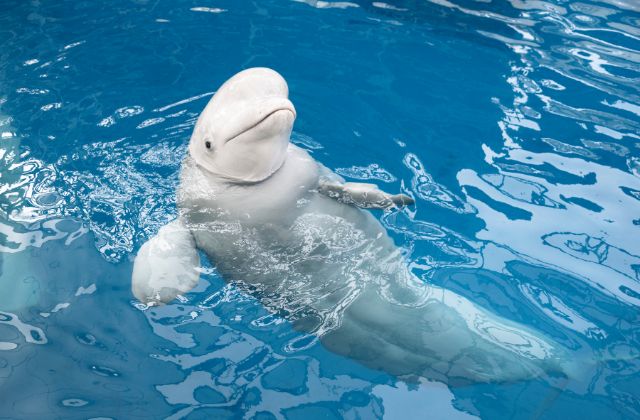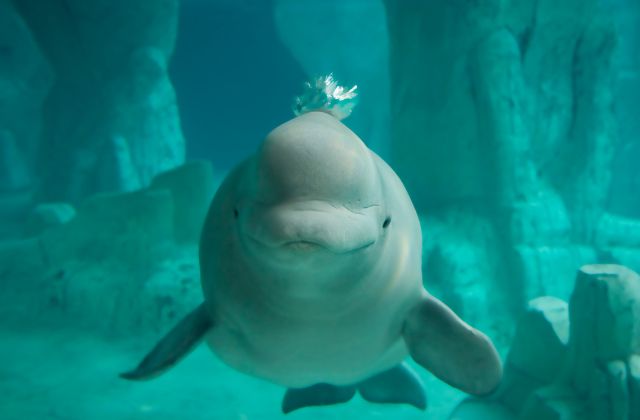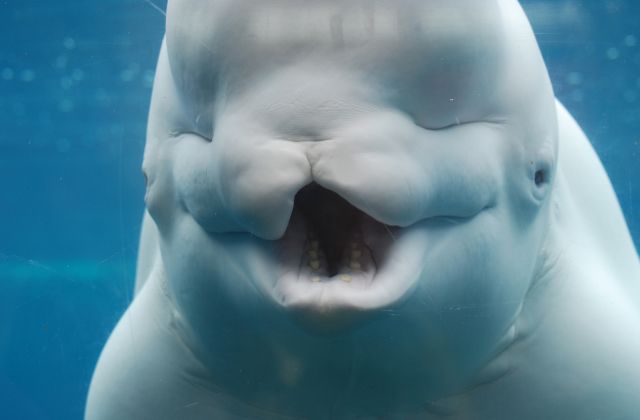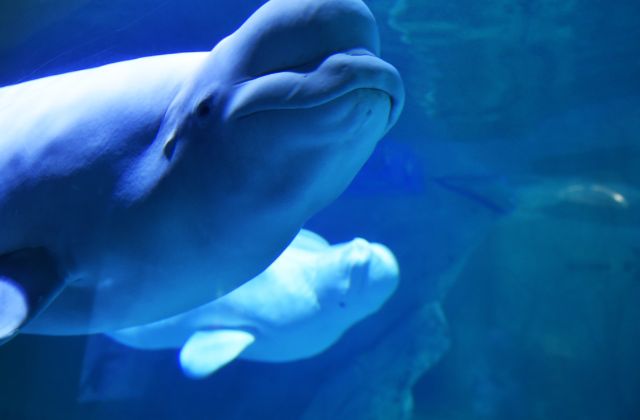12 Interesting Beluga Whale Facts For Kids (2024 Updated)
The beluga whale (Delphinapterus leucas) is an Arctic and sub-Arctic cetacean. In addition to the narwhal, it is one of only two members of the family Monodontidae and the sole representative of the genus Delphinapterus. They are one of the smallest whale species and are easily recognized by their unusual color and pronounced foreheads. Belugas are sociable animals and loud communicators who often coexist in small groups known as pods. Although they can also be found in subarctic regions, these whales are frequently seen in the coastal seas of the Arctic Ocean. They are charismatic due to their friendly demeanor, outgoing personality, and flexible, fluid movement.

Let us have a look at some interesting facts about the Beluga Whale.
12 Exciting facts about the Beluga Whale!
1. Beluga Whales are the smallest species of whales.
The body of this whale is bulky. Male belugas can grow up to 5.5 meters in length and weigh up to 1,600 kilograms; their bodies are sized between a dolphin and a regular-sized whale. Females weigh between 700 and 1,200 kg. They are considered a medium-sized species of toothed whale.
By age 10, people of both sexes have reached their maximum size. Fat folds are typically present in them, especially along the ventral side. Compared to other cetaceans that do not live in the Arctic, where fat makes up only 30% of body weight, Arctic cetaceans have between 40% and 50% of their weight in fat.
2. Beluga Whales swim rather slowly compared to other whale species.
Beluga whales may reach speeds of up to 14 mph (22 km/h) for brief periods while moving at an average pace of 2 to 6 mph (3 to 9 km/h). Most whale species move far more quickly; for instance, orca whales may swim up to 28 mph (45 km/h). Fortunately for beluga whales, consistency is the key to success. Instead of being fast swimmers, beluga whales have evolved to be highly agile animals. They can swim both forward and backward and frequently swim to depths where their bodies are barely covered.
3. Beluga Whales are deep divers!

Although belugas are not typically considered marine animals that can dive to great depths, they can. Beluga whales usually dive to a depth of 20 meters or less. A trained beluga whale went to a depth of 400 meters during training. However, they can dive far deeper than their typical maximum depth of 20 meters. The most remarkable depth ever found was 647. Belugas can stay underwater for up to 15 minutes, which is longer than the average dive time of under 10 minutes.
4. Beluga whales can save oxygen because their physiology has adapted over time.
Diverse physiological adaptations exist in all marine mammals for diving. A beluga whale can save oxygen while submerged due to these adaptations:
- When diving, beluga whales’ heart rates are slower than other marine mammals. During a dive, a beluga whale’s heart rate drops from 100 to between 12 and 20 beats per minute.
- During diving, blood is diverted from tissues that can tolerate low oxygen levels to the heart, lungs, and brain, which all require oxygen.
- Beluga whales retain more oxygen in their blood compared to most mammals. According to one study, a female beluga’s blood contains 16.5 liters of oxygen. A land mammal’s blood volume percentage is lower than a beluga whale’s (5.5%).
- The oxygen-binding protein myoglobin is highly concentrated in beluga whale muscle—myoglobin stores oxygen and aids in preventing muscular hypoxia.
5. Beluga Whales have a huge appetite.

An average beluga whale eats over 27 kg of food per day. If it doesn’t sound like much, consider this: 600 people can be fed 27 kilograms of spaghetti! Beluga whales pounce on opportunities to eat. They typically prey on bottom-dwelling creatures, numbering roughly 100 different species. They consume fish like capelin, herring, smelt, and flounder, as well as octopus, squid, crabs, sandworms, and others. Belugas hunt at the bottom of shallow water or close by. Additionally, beluga whales pursue schools of fish.
Beluga whales swallow their food whole rather than chewing it. Researchers have discovered waste in the stomachs of beluga whales, including tree bark, plants, sand, stones, and paper, likely from grazing on the ocean floor.
6. Beluga Whales are very friendly.

When migrating in the summer, beluga whales can congregate in the thousands, just as they do in the warmer waters of the Churchill and Seal River estuaries, where they feed and give birth. Beluga whales typically form groups of 10 whales, but they can congregate in the thousands during the migration. Like most whales, wild belugas are generally friendly to humans and have never been observed making any aggressive movements in their direction.
7. Researchers collect snot from Beluga Whales!
A whale exhales thousands of tiny droplets of respiratory condensate, commonly referred to as “snot,” when it surfaces to breathe. Whale snot carries a lot of biological data that has been applied globally to research diseases, stress, reproduction, genetics, and whales’ microbiome. Researchers are gathering beluga whale blow in Churchill, Manitoba, to gauge baseline stress levels to comprehend climate change.
8. Beluga Whales are very loud.
Beluga whales have loud voices. They were given the name “sea canaries” due to the frequency and variety of vocalizations. You can hear them through ship hulls and above water. Beluga whales presumably depend on sound transmission and reception to move through murky seas, communicate, find breathing holes, and hunt. Vocal cords are absent in a toothed whale’s larynx. Airflow between nasal sacs at the blowhole is what creates sound. A beluga whale’s melon changes shape as it produces sound. There are at least 11 different beluga vocalizations that have been recorded, including bell-like tones, high-pitched, resonant whistles and squeals, clucks, mews, and chirps.
9. Beluga Whales’ heads and necks differentiate them from other whale species.
A rounded feature called the melon is on the dorsal surface of a whale’s head, directly in front of the blowhole. It is prominent and hangs over the rostrum of beluga whales. Lipids make up the melon.
A beluga’s melon is more malleable than other whale species. When the whale makes noises, it changes shape. Sound creation is made more accessible by the melon. When the whale makes noises, it changes shape.
Because the neck vertebrae of belugas are not fused like those of other whales and dolphins, providing the species’ neck more flexibility and mobility, they may nod and turn their heads from side to side, which most other whales can’t do.
10. Beluga Whales can swim under the ice.
They are kept warm by 1.5 feet of blubber. They breathe through tiny gaps in the sea ice with their raised blowholes. In addition to having less surface area to prevent heat loss, the beluga without a dorsal fin may more easily swim beneath the ice to find breathing holes. A hardened crest on the dorsal ridge, which beluga have in place of a dorsal fin, enables them to break through ice to create breathing holes. In the winter, belugas risk becoming trapped by sea ice if they don’t migrate south quickly enough. Because it is easier to keep these holes open when there are many whales present, their constant movement and surfacing can help to keep them open for longer than if the water were calm, giving them a higher chance of survival than they would have on their own.
11. Beluga whales give birth once every 3-4 years.

After the age of four, female beluga whales reach sexual maturity, after which they have a 14-month-long pregnancy, followed by an extended 18-month nursing period. Female Belugas often stop giving birth when they are 25 years old.
Females only reproduce every three years because of the extensive pregnancies and the calves’ dependence on their moms. Calves are roughly the size of an ordinary grown man, weighing around 80 kg and about 1.5 meters long when born. The calf’s swimming ability is present from the moment of birth. The position of the pod has some bearing on the calving seasons. Depending on the location, calves are born from March to September. Most are born between May and July. Twins are pretty uncommon.
12. Hunting and diseases are the leading causes of Beluga Whale deaths.
Beluga whale fatalities may be caused by several diseases, just like in other animal groups. These include bacterial, fungal, and viral infections, skin, cancers, heart conditions, urogenital problems, and respiratory issues. Toxic pollution may cause or exacerbate some of these conditions.
Apart from diseases, hunting has been the number one cause of beluga whale deaths since ancient times. Beluga whales have been sought after for their meat, fat, and skin by native Arctic populations in colder places like Alaska, Russia, and Canada. Beluga is the only fish with skin thick enough to be used in making leather. The number of beluga whales in the Arctic regions of Canada declined in the 18th and 19th centuries due to European and American commercial beluga hunting. Europeans also utilized the refined melon oil produced by beluga whales to oil watches, machinery, and power lighthouses. Whalers from Scotland and America killed more than 19,000 belugas between 1868 and 1911 in the Davis Strait and Lancaster Sound.
Fishermen on the St. Lawrence River murdered beluga whales in the 1930s because they thought the whales posed a threat to the fishing industry.
Conclusion
Beluga Whales are among the most popular and charismatic whales among marine animals. Their friendly demeanor, communication style, and flexible, elegant movement make them prone to be housed in aquariums and wildlife parks in North America, Europe, and Asia.
